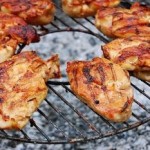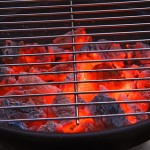Cold-weather grilling with the Super-Fast® Thermapen®
Any seasoned grill master (brave enough to fire up the pit in the dead of winter) can tell you how difficult it is to get accurate temperature measurements in cold weather. If you’re not battling rain, sleet and snow, you’re likely going toe-to-toe with below-freezing temperatures, early signs of frost bite or worse – wind.
In cold weather, a stiff wind can bring a red-hot cooker to its knees. Not only that, but cold convection currents blowing over your grates can take a piece of meat from a blistering 120°F (surface temperature) to a frigid 110°F in no time.
A tight lid and a stoked fire will go a long way to ensure that Old Man Winter keeps his mitts off of your meat. However, every experienced grill master knows at some point their meat is going to need to be flipped, turned and temped – and that’s going to require a date with the elements.
The key is to be focused (with tools in-hand) before you break the seal on your cooker. You’re only going to have a few seconds under the hood before your temps start reading cold and a chicken breast can go from juicy to jaded (dry). It’s important to have a speedy thermometer (like the Super-Fast Thermapen) when making the flip because in this situation, time is of the essence. By the time you’ve made the rounds, you’re going to start seeing discrepancies in the readings. The faster you’re able to go the less heat you’re going to lose. Think of yourself as a pit man at the Daytona 500, get in and get out as fast as you can – from lid open to close in less than 10.2 seconds!
If you’re making the rounds on twelve breasts of chicken – making sure to get a fast accurate reading from each one, because by the time you get back to the first, the sharp convection currents may have chilled them all a degree or two – or more. This little hiccup in the grilling process often leaves some chefs scratching their heads.
Just remember: The highest temperature reached should be your guide – even if it drops again. Because – and this is important – you can’t “un-cook” a piece of meat!
If you leave a piece of meat on the grill in an attempt to bring it back up to temperature – say from 140°F back to 160°F – if it’s already been there, any further cooking and you’ll risk drying it out.
When attending to your meat, remember that the center temperature is the most important – especially in colder weather. Instead of coming at your meat from the surface that’s exposed to the wind, take a center reading from the side right before the flip, and then another right after to see if there is any cooling taking place. Ask yourself, “How hot did it get?” – not – “How hot is it?”
(To answer the question, “How hot did it get?”, it’s important that you try and temp the meat when it’s at it’s hottest – as soon after you open the lid to your cooker as possible. If you take too long with your thermometer you may have already missed it.)
The truth is, if you’re outside cooking in the cold you’ve already overcome the most difficult part (i.e. leaving the comfort of your kitchen). The rest comes from experience and great temperature tools. Get yourself a red-hot grill, a spring-loaded pair of tongs and a Super-Fast and accurate Thermapen and you’ll be alright.
Tell us your best cold-weather grilling story!




This is an awesome reminder to keep grilling in the winter because food’s always better off the grill. The Super-Fast Thermapen is great but don’t forget the flashlight cause by the time I ran back in the house the speed of my Thermapen could no longer help me! Maybe next time I’ll try a head lamp for night grilling then I’ll have one free hand for tongs and the other for my Thermapen. 8)
The Thermapen is so accurate, I was out grilling in -18 Celcious with a wind chill factor of – 29 Celcious in Ottawa Canada and my strip loin 1″ thick steaks came out perfect. It is so nice to have this Themapen and not have to eat well done meat. Thanks Thermoworks for a great product!!
Winter grilling is the best!!! It brings a little summer to the winter